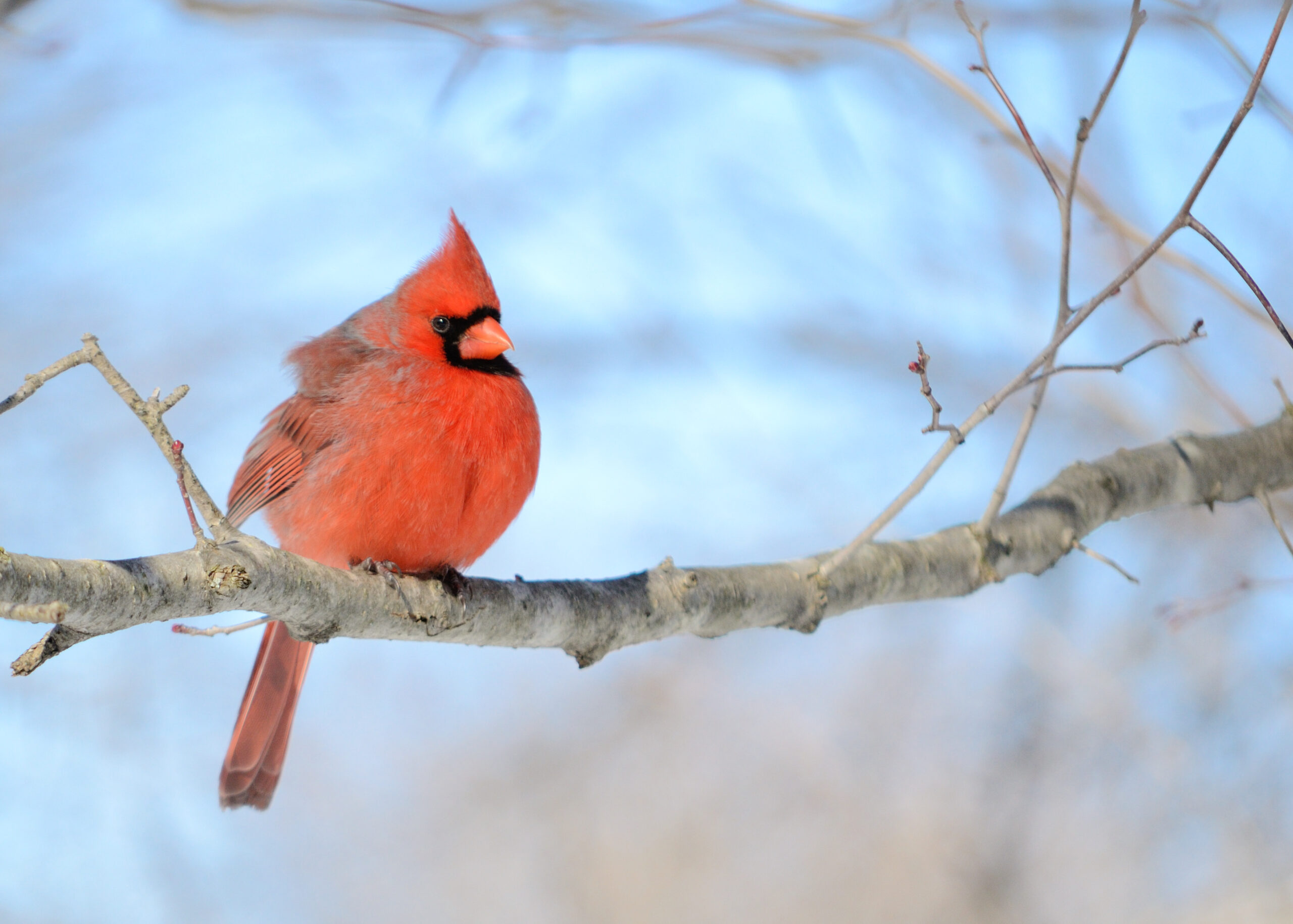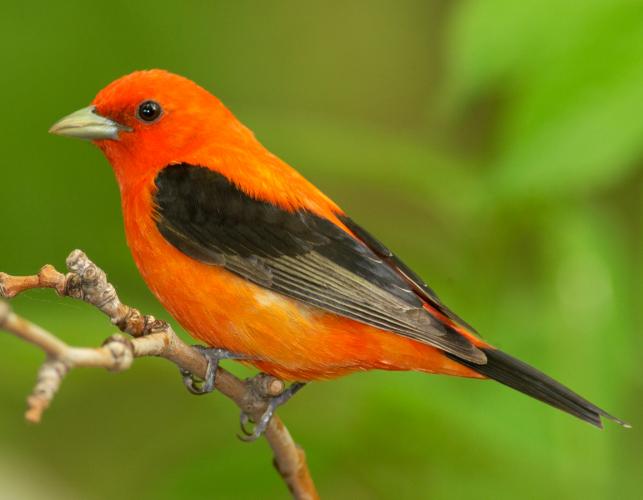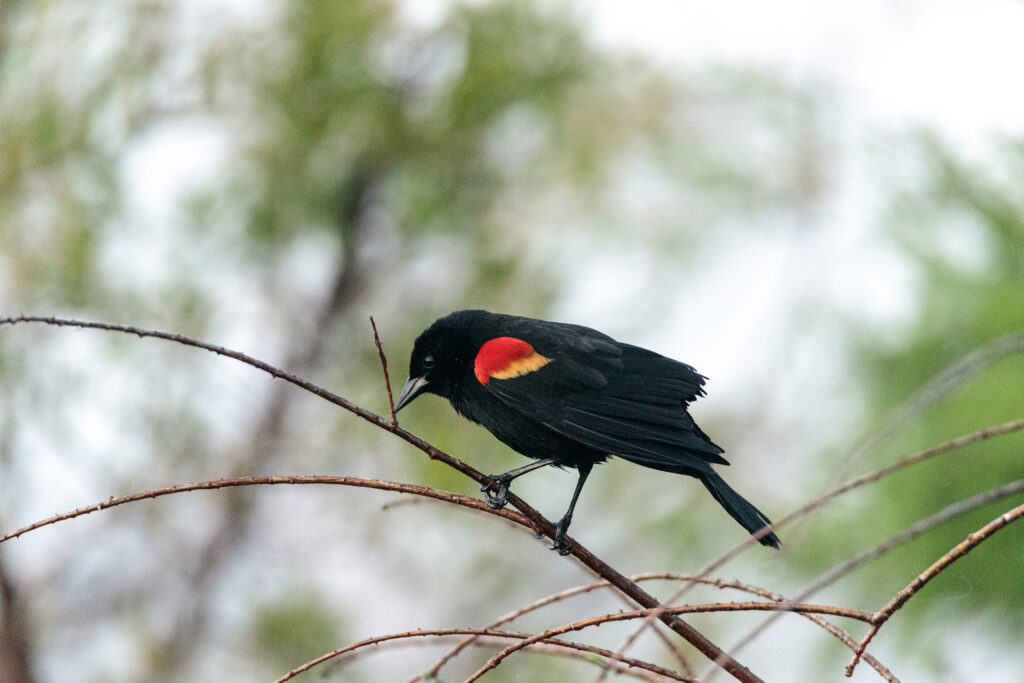Hello! If you’re a bird enthusiast or just someone who loves nature, you’ll be thrilled to learn about the 11 types of red birds that you can spot in North Carolina.
North Carolina is home to a diverse range of bird species, and the red birds are some of the most beautiful and striking.
In this article, I’ll introduce you to these 11 red birds and share some fascinating facts about each one.
So let’s get started and explore the vibrant world of red birds in NC!
| Name | Name |
|---|---|
 | Northern Cardinal |
 | Northern Flicker |
 | House Finch |
 | Summer Tanager |
 | Scarlet Tanager |
 | Red Headed Woodpecker |
 | Red Bellied Woodpecker |
 | Red Winged Blackbird |
 | Ruby Throated Hummingbird |
 | Rose Breasted Grosbeak |
 | Painted Bunting |
Types of Red Birds in North Carolina (NC)
1. Northern Cardinal

You may see Northern Cardinals all around the state of North Carolina any time of the year.
The head plumes of a northern cardinal resemble a mohawk, and the bird’s red body and beak are contrasted by black markings across its face.
While the bulk of a female bird’s feathers is light brown, there are minor patches of red on the beak and body.
Whether the sugar water or grains in the feeders suit their taste buds, these cardinals may be discovered in shrublands, wooded parks, gardens, and waterways.
Their diet consists mostly of tiny insects, including caterpillars, true bugs, beetles, grasshoppers, flies, ants, spiders, snails, and centipedes.
They also eat the seeds of weeds and a variety of berries, and other tiny foods.
There are reports of northern cardinals living up to 15 years in the wild, although the true lifespan is likely much lower.
2. Northern Flicker

This species of northern flicker is permanently resident in the state of North Carolina.
A northern flicker’s body is predominantly white with mixed black patches; the bird’s tail appears black and orange, and the bird has hints of scarlet on its lower face.
The females are almost indistinguishable from the males but for the absence of the red features.
Northern flickers are common sights in wooded areas, forest fringes, broad fields with little forest vegetation, and even urban and suburban parks.
Its diet often consists of smaller fruits and berries, as well as insects.
On average, the life span of a northern flicker is estimated to be between 5 and 7 years, with the highest lifespan ever documented being nine years and 65 days.
3. House Finch

Each and every county across North Carolina is home to house finches that stay all year long.
A House finch’s head is a gradient of red with touches of brown, and its body is primarily a light brown.
Males are completely black, while females are primarily brown with some black on the wings and back.
House finches may be found in a wide variety of environments, including those at altitudes below 6,000 feet, including desert meadows, dry deserts, chaparral, streamside, oak savannah, and open deciduous woods.
They sometimes visit a citizen-maintained feeder in search of a suitable diet, such as black sunflower seeds.
House finches consume not just seeds but also tiny insects such as aphids, berries, and fruit.
House finches have a lifespan of around 11 years in the wild and up to 13 years in captivity.
4. Summer Tanager

When it’s time for the summer tanagers to breed in the spring and summer, you may find them all across the state of North Carolina.
The male summer tanager is easily distinguished by his almost all-red plumage and his grayish/silver beak.
On the contrary, females tend to be mostly yellow.
The summer tanager often inhabits lowland tropical woods with a high tree cover and open areas.
Also suitable for their needs are habitats located at altitudes of up to 1800 meters above sea level.
Tanagers mostly subsist on tiny insects, including wasps and bees; however, they may sometimes eat berries and other small foods they find in parks and gardens.
The typical lifespan of a summer tanager in the wild is estimated to be approximately 5 to 6 years.
5. Scarlet Tanager

Scarlet tanagers may be seen along the eastern coast of North Carolina during migration, and they can be seen elsewhere in the state during the mating season.
The scarlet tanager is named for its black wings, bright red feathers, and gray or silvery beak.
The females are distinguished from the males by their black wings and green feathers.
Deciduous forests, where beech, maple, oak, and other trees thrive, are home to these tanagers.
In addition to living in pine-oak forests, these creatures are also sometimes seen in pine- and hemlock-dominated coniferous forests.
Scarlet tanagers get most of their nutrition from insects, including moths, caterpillars, aphids, wasps, bees, and beetles, as well as berries and tiny fruits.
While scarlet tanagers have a theoretical 12-year lifespan in the wild, the average scarlet tanager probably won’t make it beyond the age of 7.
6. Red Headed Woodpecker

Red-headed Woodpeckers live all year round across North Carolina.
The red cap atop their otherwise black and white wings and body makes red-headed woodpeckers easy to spot.
These woodpeckers are most often seen in areas with dense stands of trees, such as orchards, forest borders, farmland, and broad pine forests.
Insects like earthworms and spiders, as well as berries, seeds, nuts, and certain other fruits, make up the bulk of a red-headed woodpecker’s diet.
These peckers have been known to consume the contents of other birds’ eggs and even little animals.
Red-headed woodpeckers have an incredible longevity of up to ten years in the habitat.
7. Red Bellied Woodpecker

The state of North Carolina is home to red-bellied woodpeckers all year round.
The red streak on its head, the white plumage on its breast, and the zebra-like stripes on its back and wings are the telltale signs of a red-bellied woodpecker.
As befits a member of the woodpecker family, their bills are usually long and sharp.
The only distinguishing feature of females is the absence of a red stripe on their heads; otherwise, they are very identical to males.
Suet, particularly nut, insect, or fruit mixtures, is a favorite food of red-bellied woodpeckers, as are sunflower seeds, grapes, oranges, apples, and other smaller insects.
Their preferred habitat includes wooded areas with a variety of tree species, from ancient oaks to younger hardwoods and pines.
They also often visit the garden feeders of Missourians.
The average lifespan of a wild red-bellied woodpecker is between 10 and 12 years.
8. Red Winged Blackbird

Blackbirds with red wings are a year-round fixture throughout the state.
Such as the red-bellied woodpecker up above; red-winged blackbirds are primarily black but have some red accents, in this instance, on their wings.
Females seem considerably different from males; they are shorter and lack the males’ signature red wing spot.
Their feathers are a spotted gray, black, and white rather than a solid color.
Common habitats for these blackbirds are forested or weedy meadows, brushy swamps, hayfields, and the higher borders of salt marshes, as well as freshwater marshes.
Common places for red-winged blackbirds to forage are meadows and mudflats.
Seeds make up the bulk of their meal, but they also consume tiny insects, including flies and snails, as well as larger prey, such as crayfish, lizards, and even fruits.
In the wild, its lifespan is typically 2 to 4 years; however, captive specimens have been reported to live far into their 20s.
9. Ruby Throated Hummingbird

North Carolina is home to breeding populations of ruby-throated hummingbirds, mostly in summer and late spring.
A ruby-throated hummingbird has distinctive red, white, and greenish feathers.
The bird’s neck is red, its chest and abdomen are white, and its wings and back are olive green.
Most females are a pale green hue.
Their diet consists mostly of nectar but also includes tiny insects, fruit, sugar water from feeders, tree sap, and naturally occurring floral sugars.
The high metabolic rate of the ruby-throated hummingbird necessitates that it eat often; hence these birds like to congregate in areas with flowerbeds.
As a result, their natural habitats include places like gardens, parks, and even forest hillsides.
The usual longevity of these little hummingbirds is estimated to be between 3 and 6 years, with the maximum duration documented being over seven years.
10. Rose Breasted Grosbeak

Western North Carolina is where you’re most likely to see rose-breasted grosbeaks, while the rest of the state is only utilized by these birds as a transit point during their annual migrations.
The backs of rose-breasted grosbeaks appear black, the wings and wing-tail plumage are a combination of white and black, the breasts are white, and there is a small patch of red near the neck.
In contrast, females tend to be a mix of white and brown.
The preferred habitats of these grosbeaks are woods, deciduous forests, meadows, and parks.
Rose-breasted grosbeaks have been seen eating anything from berries and other tiny fruits to tiny insects and seeds such as safflower and sunflower.
It is estimated that rose-breasted grosbeaks may live for eight years in their natural environment but can survive up to 23 years in captivity.
11. Painted Bunting

During the mating season (usually spring and summertime), painted buntings may be observed across southeastern North Carolina.
Although painted buntings display a rainbow of hues, the most common are red on the chest, neck, and lower back, blue on the head, and greenish on the wing and upper back.
The females, in contrast, are primarily green.
Buntings with brightly colored designs may be seen flying over forest margins, thickets, and vegetation and riparian thickets.
Seeds (especially those of grasslands and weeds), tiny fruits, berries, and a wide range of tiny invertebrates make up the bulk of their diet.
Although certainly painted buntings have been reported to survive for more than ten years, the typical lifespan is closer to 5 to 7 years.
Conclusion
In conclusion, North Carolina is home to a diverse range of red bird species that add vibrancy and beauty to its natural landscape.
From the iconic Northern Cardinal to the striking Rose Breasted Grosbeak, these birds come in all shapes and sizes and can be found in various habitats across the state.
While some red bird species are year-round residents, others are migratory and only visit during certain times of the year.
Regardless of their status, all of these red birds are an integral part of North Carolina’s ecosystem and contribute to its ecological balance.
As such, it is important to appreciate and protect these magnificent creatures for future generations to enjoy.
FAQ
What is the most common red bird in North Carolina?
The Northern Cardinal is the most common red bird in North Carolina, and can be found throughout the state year-round.
Are all red birds in North Carolina permanent residents?
No, not all red birds in North Carolina are permanent residents. Some species, such as the Scarlet Tanager and Summer Tanager, are migratory and only visit the state during certain times of the year.
Are all red birds in North Carolina true red in color?
No, not all red birds in North Carolina are true red in color. Some species, such as the Scarlet Tanager and the Vermilion Flycatcher, have variations of red and orange in their plumage.
Where can I go to see red birds in North Carolina?
Red birds can be found in a variety of habitats across North Carolina, including forests, wetlands, and even suburban areas. Some popular birding spots include the Great Smoky Mountains National Park, Cape Hatteras National Seashore, and the Outer Banks.
Are red birds in North Carolina endangered?
While some red bird species in North Carolina, such as the Red-cockaded Woodpecker, are considered endangered or threatened, most red bird species in the state are currently not at risk of extinction.
What is the difference between a male and female Northern Cardinal?
Male Northern Cardinals are bright red with a black mask on their face, while females are a more subdued reddish-brown with touches of red on their wings, tail, and crest.
How can I attract red birds to my backyard?
Red birds can be attracted to backyard bird feeders that offer sunflower seeds, safflower seeds, or peanuts. Planting native vegetation and providing nesting boxes may also attract red birds to your yard.
Last Updated on May 3, 2023 by Lily Aldrin
